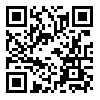Volume 9, Issue 2 (spring & summer 2014)
ijpd 2014, 9(2): 7-12 |
Back to browse issues page
Download citation:
BibTeX | RIS | EndNote | Medlars | ProCite | Reference Manager | RefWorks
Send citation to:



BibTeX | RIS | EndNote | Medlars | ProCite | Reference Manager | RefWorks
Send citation to:
Hajenoruzali Tehrani M, Bahmani P, Shahtusi M. Evaluation of relationship between socio-demographic factors and prevalence of digit sucking at 4-6 years old children . ijpd 2014; 9 (2) :7-12
URL: http://jiapd.ir/article-1-35-en.html
URL: http://jiapd.ir/article-1-35-en.html
Abstract: (5276 Views)
Background and Aims: choice correct preventive way of a diseases or abnormality Particular without notice to etiologic factors is not effective and oral habit is environment etiologic factors in orthodontic problem. The aim of the study is define the relationship between social and demographic factors with prevalence of Digit sucking in 4 to 6 years old children in Busher Dashty city. Materials and Methods: Study type is descriptive analytic cross - section .the purpose group was 4 to 6 years old children. Group of 630 individuals were selected cluster random sampling manner. Data gain by question of parent and family, hygiene file evaluation and use of check listed. Results: Digit sucking is higher prevalence among girls. 131 children with digit sucking and 499 no digit sucking. 73 girls (55/7%) and 58 boys (44.3%) have Digit sucking habit. Digit sucking in higher prevalence among children which the family smoking and haven't owned home .long bottle feeding periods and use of pacifier showed a preventive effect against finger sucking Conclusion: Digit sucking has relation with children sex. The family use of smoking and have owned home relation to digit sucking and decrease in Digit sucking children is as a result of bottle feeding period's longer than12 months or use of pacifier. Propos responsible hygiene country with effect education plane about recognize appropriate and effective factors of Digit sucking and in early items can waste less time an investment prevention of Digit sucking. Propos to parent if your child wants to suck their digit you should offer him or her pacifier.
Type of Article: Research Article |
Subject:
General
Received: 2015/01/28 | Accepted: 2015/01/28 | Published: 2015/01/28
Received: 2015/01/28 | Accepted: 2015/01/28 | Published: 2015/01/28
References
1. Mehrdad K. Oral habits-definition and types. Beheshti Univ Dent J. 1992; 3:12-6. [In Persian]
2. Pazhand H. Orthodontic and operative dentistry for children. Iran, Mashhad: Ferdowsi University Publication; 1997. [In Persian]
3. Levine RS. Briefing paper: Oral aspect of dummy and digit sucking. Br Dent J. 1999; 185(3):108. [DOI:10.1038/sj.bdj.4800035a]
4. Farsi NM, Salama FS. Sucking habits in Saudi children: prevalence, Contributing factors and effect on the primary dentition. Pediatr Dent. 1997; 19(1):28-33.
5. Pinkham JR. Pediatric Dentistry, Infancy Through Adolescence. 3rd ed. Philadelphia, W.B. Saunders Co., 1999.
6. Johnson ED, Larson BE. Thumb sucking: classification and treatment. ASDC J Dent Child. 1993; 60(4):392-8.
7. Lubiz L. Nail biting thumb sucking and other irritating behaviors in childhood. Aust Fam Physician. 1992; 21(8):1090-4
8. Van Norman RA. Digit-sucking: a review of the literature, clinical observations and treatment recommendations. Int J Orofacial Myology. 1997; 23:14-34.
9. Khayami S, Bennani F, Farella M. Fingers in mouths: from cause to management. N Z Dent J. 2013; 109(2):49-50, 52-4.
10. Sandler PJ, Madahar AK, Murray A. Anterior open bite: aetiology and management. Dent Update. 2011; 38(8):522-4, 527-8, 531-2. [DOI:10.12968/denu.2011.38.8.522]
11. Larsson E. Artificial sucking habits: etiology, prevalence and effect on occlusion. Int J Orofacial Myology. 1994; 20:10-21.
12. Proffit WR, Fields HW, Sarver DM. Contemporary orthodontics. 5th ed. St Louis: Mosby; 2012.
13. World Health Organization. Basic approach in oral and dental health research in Tehran. 1998; 10-36. [In Persian]
14. North Stone K, Fleming P, Golding J. Socio-demographic associations with digit and pacifier sucking at 15 months of age and possible associations with infant infection. The ALSPAC Study Team. Avon Longitudinal Study of Pregnancy and Childhood. Early Hum Dev. 2000; 60(2):137-48. [DOI:10.1016/S0378-3782(00)00113-4]
15. Larsson E. The prevalence and aetiology of prolonged dummy and finger-sucking habits. Eur J Orthod. 1985; 7(3):172-6. [DOI:10.1093/ejo/7.3.172]
16. Bosnjak A, Vućićević-Boras V, Miletić I, Bozić D, Vukelja M. Incidence of oral habits in children with mixed dentition. J Oral Rehabil. 2002; 29(9):902-5. [DOI:10.1046/j.1365-2842.2002.00925.x]
17. Moimaz SA, Zina LG, Saliba NA, Saliba O. Association between breast-feeding practices and sucking habits: a cross-sectional study of children in their first year of life. J Indian Soc Pedod Prev Dent. 2008; 26(3):102-6. [DOI:10.4103/0970-4388.43188]
18. Jahanbin A, Mokhber N, Jabbarimani A. Association between sociodemographic factors and nutritive and non-nutritive sucking habits among Iranian girls. East Mediterr Health J. 2010; 16(11):1143-7.
19. Vadiakas G, Oulis C, Berdouses E. Profile of non-nutritive sucking habits in relation to nursing behavior in pre-school children. J Clin Pediatr Dent. 1998; 22(2):133-6.
20. Branam S. Role of oral habits in children accessed [Internet]. Year [cited 2003 may 4]. Available from: http://www.Dr branam.com
21. Paul S. Casamassimo, Henry W. Fields Jr. Pediatric Dentistry: Infancy through Adolescence. 5th ed. St. Louis, Mo.: Elsevier/Saunders; 2013.
| Rights and permissions | |
 |
This work is licensed under a Creative Commons Attribution-NonCommercial 4.0 International License. |





